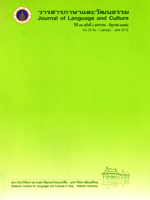An analysis of conversational structures between local government officials and ethnic people
Main Article Content
Abstract
This research aims to study conversational structures between the local government officials and ethnic people at the Registry Office, Chiangkam District, Phayao Province, Thailand. The data was collected by recording natural conversations and observing the behavior of local government officials and ethnic people during their conversations. There were a total of 50 conversations recorded. Data from the recorded conversations were analyzed based on Sacks, Schegloff and Jefferson (1974) conversational analysis approach.
The results of this study reveal that conversational structures can be divided into three sections: opening section, body section, and closing section. These conversations are different from regular conversations in that they highlight the status and rights of ethnic people. Most conversations are initiated by local government officials: 1) getting attention by calling or calling out the name of an ethnic person, 2) asking questions concerning the purpose of the visit to the Registry Office, 3) using utterances that show continuity from the previous conversation, and 4) describing process details or procedures. For ethnic people, they tend to start the conversation by 1) calling out thename of the local government official they wished to see, 2) greeting, and 3) stating the purpose of their visit immediately. Conversations between local government officials and ethnic visitors tended to be of a questions and answer format to the end of the conversation. It is a unique pattern of government contact in which local government officials acquire information from visitors, in such a way that it implies their authority.
Article Details
The articles featured in the Journal of Language and Culture (JLC) constitute academic works representing the viewpoints of the respective author(s). It is crucial to note that these opinions do not necessarily reflect those of the Editorial Board.
All articles published in JLC are released under the Creative Commons Attribution 4.0 International License (CC BY 4.0). This license grants permission for unrestricted use, distribution, and reproduction in any medium, provided proper credit is given to the original author(s) and the source.


